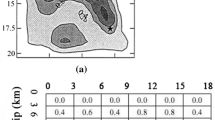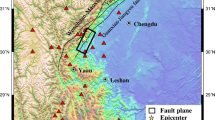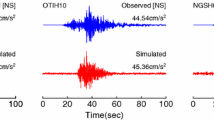Abstract
On May 21, 2021, at 21:48 local time, an earthquake with a moment magnitude of 6.1 occurred in Yangbi County, Yunnan Province, China. By using the robust strong ground motion data released by the Yunnan Earthquake Agency, we selected five near-field stations (R < 100 km) and determined model parameters, such as the duration, spectral attenuation, stress drop, and site amplification factors of the 2021 Mw 6.1 Yangbi earthquake in China. These model parameters required for the simulation were fed into a stochastic finite-fault model of the corner frequency associated with a dislocation. The modified stochastic finite-fault method was applied to simulate the acceleration recordings of these five near-fault stations, and the acceleration response spectra and Fourier acceleration spectrum were obtained. Comparative observation results reveal that the key input parameters extracted from a few stations and the revised approach established in the current study can adequately predict the near-fault ground motion at high frequencies of the Yangbi earthquake and can demonstrate the contribution of areas with large slips to radiated energy. The proposed method can provide a basis for postdisaster rescue and seismic building design for this region.








Similar content being viewed by others
References
Anderson JG, Hough SE (1984) A model for the shape of the Fourier amplitude spectrum of acceleration at high frequencies. Bull Seismol Soc Am 74(5):1969–1993
Atkinson GM, Boore DM (1998) Evaluation of models for earthquake source spectra in Eastern North America. Bulletin of the Seismological Society of America 1998; 88(4): 917–934
Beresnev IA, Atkinson GM (1997) Modeling finite-fault radiation form the ωn spectrum. Bull Seismol Soc Am 87(1):67–84
Beresnev IA, Atkinson GM (1998) FINSIM-a FORTRAN program for simulating stochastic acceleration time histories from finite faults. Seismol Res Lett 69(1):27–32
Bolt BA (1973) Duration of strong ground motion. See: Proceeding of the 5th WCEE, Rome, Italy. 1973; 1: 1304–1313
Boore DM (1983) Stochastic simulation of high-frequency ground motion based on seismological models of the radiated spectra. Bull Seismol Soc Am 73(6):1865–1894
Boore DM (2001) Effect of baseline corrections on displacements and response spectra for several recordings of the 1999 Chi-Chi, Taiwan. Bull Seismol Soc Am 91(5):1199–1211
Boore DM (2003) Simulation of ground motion using the stochastic method. Pure appl Geophys 160(3):635–676
Boore DM (2009) Comparing stochastic point-source and finite-source ground-motion simulations: SMSIM and EXSIM. Bull Seismol Soc Am 99(6):3202–3216
Boore DM, Joyner WB (1997) Site amplifications for generic rock sites. Bull Seismol Soc Am 87(2):327–341
Chen JL, Hao JL, Wang Z, Xu T (2022) The 21 May mw 6.1 Yangbi earthquake – a unilateral rupture event with conjugately distributed aftershocks. Seismol Res Lett 93(3):1382–1399
Chopra S, Kumar D, Choudhury P, Yadav RBS (2012) Stochastic finite fault modelling of mw 4.8 earthquake in Kachahh, Gujarat, India. J Seismolog 16:435–449
Dabaghi M, Kiureghian AD (2016) Stochastic model for simulation of near-fault ground motion. Earthq Eng Struct Dynamics 46(6):963–984
Dang PF, Liu QF, Song J (2020) Simulation of the Jiuzhaigou, China, earthquake by stochastic finite-fault method based on variable stress drop. Nat Hazards 103(2):2295–2321
Dang PF, Liu QF, Xia SL, Ma WJ (2021) A stochastic method for simulating near-field seismograms: application to the 2016 Tottori earthquake. Earth and Space Science 8(11):e2021EA001939
Dang PF, Cui J, Liu QF, Xia SL (2022a) Slip-correlated high-frequency scaling factor for stochastic finite-fault modeling of ground motion. Bull Seismol Soc Am 112(3):1472–1482
Dang PF, Cui J, Liu QF (2022b) Parameter estimation for predicting near-fault strong ground motion and its application to Lushan earthquake in China. Soil Dyn Earthq Eng 156:107223
Dang PF, Cui J, Liu QF, Ji LJ (2023) A method for predicting hybrid source model of near-field ground motion: application to Yangbi earthquake in China. Seismol Res Lett 94(1):189–205
Douglas J, Gehl P, Bonilla LF, Gelis C (2010) A κ model for mainland France. Pure appl Geophys 167(11):1303–1315
Hough SE, Anderson JG (1988) High frequency spectra observed at Anza: implications for Q structure. Bull Seismol Soc Am 78(2):692–707
Husid RL (1969) Analisis de terremotos, Analisis general. Reevista del IDIEM 8(1):21–42
Karagoz O, Chimoto K, Yamanaka H, Ozel O, Citak S (2018) Broadband ground-motion simulation of the 24 May 2014 Gokceada (North Aegean Sea) earthquake (mw 6.9) in NW Turkey considering local soil effects. Bull Earthq Eng 16:23–43
Konno K, Ohmachi T (1998) Ground-motion characteristics estimated from spectral ratio between horizontal and vertical component of microtremor. Bull Seismol Soc Am 88(1):228–241
Ktenidou OJ, Gelis C, Bonilla LF (2013) A study on the variability of kappa (κ) in a borehole: implications of the computation process. Bull Seismol Soc Am 83(5):1574–1594
Lermo J, Chavez GFJ (1993) Site effect evaluation using spectral ratios with only one station. Bull Seismol Soc Am 83(5):1574–1594
Liu XG, Xu WB, He ZL, Fang LH, Chen ZD (2022) Aseismic slip and cascade triggering process of foreshocks leading to the 2021 mw 6.1 Yangbi earthquake. Seismol Res Lett 93(3):1413–1428
Mavroeidis GP, Papageorgiou AS (2003) A mathematical representation of near-fault ground motions. Bull Seismol Soc Am 93:1031–1099
Meneisy AM, Toni M, Omran AA (2020) Soft sediment characterization using seismic techniques at Beni Suef city, Egypt. J Environ Eng Geophys 25(3):391–401
Mir RR, Parvez IA (2020) Ground motion modelling in northwestern Himalaya using stochastic finite-fault method. Nat Hazards 103:1989–2007
Mittal H, Wu YM, Chen DY, Chao WA (2016) Stochastic finite modeling of ground motion for March 5, 2012, mw 4.6 earthquake and scenario greater magnitude earthquake in the proximity of Delhi. Nat Hazards 82:1123–1146
Motazedian D, Atkinson GM (2005) Stochastic finite-fault modeling based on a dynamic corner frequency. Bull Seismol Soc Am 95(3):995–1010
Motazedian D, Moinfar A (2006) Hybrid stochastic finite fault modeling of 2003, M6.5, bam earthquake (Iran). J Seismolog 10:91–103
Pan D, Miura H, Kanno T, Shigefuji M, Abiru T (2022) Deep-neural-network-based estimation of site amplification factor from microtremor H/V spectral ratio. Bull Seismol Soc Am 112(3):1630–1646
Pezeshk S, Farhadi A, Haji-Soltani A (2022) A new model for vertical-to-horizontal response spectral ratios for central and eastern north America. Bull Seismol Soc Am 112(4):2018–2030
Qiang SY, Wang HW, Wen RZ, Li CG, Ren YF (2021) Three-dimensional ground motion simulations by the stochastic finite-fault method for the Yangbi, Yunnan Ms6.4 earthquake on May 21, 2021. Chin J Geophys 64(12):4538–4547. https://doi.org/10.6038/cjg2021P0404(In Chinese)
Roumelioti Z, Beresnev IA (2003) Stochastic finite-fault modeling of ground motions from the 1999 Chi-Chi, Taiwan, earthquake: application to rock and soil sites with implications for nonlinear site response. Bull Seismol Soc Am 93(4):1691–1702
Sun JZ, Yu YX, Li YQ (2018) Stochastic finite-fault simulation of the 2017 Jiuzhaigou earthquake in China. Earth Planets and Space 70:128
Tafreshi MD, Bora SS, Ghofrani H, Mirzaei N, Kazemian J (2022) Region- and site-specific measurements of kappa (κ0) and associated variabilities for Iran. Bull Seismol Soc Am 112(6):3046–3062
Takizawa AH, Jennings PC (1990) College of a model for ductile reinforced concrete frame under extreme earthquake motions. Earthquake Eng Struct Dynam 8(2):117–144
Toni M (2017) Simulation of strong ground motion parameters of the 1 June 2013 Gulf of Suez earthquake, Egypt. NRIAG J Astron Geophys 6(1):30–40
Wang ZY (2017) Research on stochastic method for high frequency of ground motions. Ph. D thesis. Harbin: Institute of Engineering Mechanics, China Earthquake Administration; (In Chinese)
Wang M, Shen ZK (2020) Present-day crustal deformation of continental China derived from GPS and its tectonic implications. J Geophys Res 125(2). https://doi.org/10.1029/2019JB018774
Wang HW, Ren YF, Wen RZ (2018) Source parameters, path attenuation and site effects from strong-motion recordings of the Wenchuan aftershocks (2008–2013) using a non-parametric generalized inversion technique. Geophys J Int 212:872–890
Xu Y, Herrmann RB, Wang CY (2010) Preliminary high-frequency ground-motion scaling in Yunnan and southern Sichuan, China. Bull Seismol Soc Am 100(5B):2508–2517
Yaghmaei-Sabegh S, Tsang HH (2011) An updated study on near-fault ground motions of the 1978 Tabas, Iran, earthquake (mw = 7.4). Scientia Iranica 18(4):895–905
Yalcinkaya E, Pinar A, Uskuloglu O, Tekebas S, Firat B (2012) Selecting the most suitable rupture model for the stochastic simulation of the 1999 Izmit earthquake and prediction of peak ground motions. Soil Dyn Earthq Eng 42:1–16
Yang LW, Cui JW, Zhang TJ, Lin GL (2021) Analysis of near-field strong motion characteristics of the Yangbi M6.4 earthquake in Yunnan province in 2021. World Earthq Eng 37(4):81–90 (In Chinese)
Zafarani H, Rahimi M, Noorzad A, Hassani B, Khazaei B (2015) Stochastic simulation of strong-motion records from the 2012 Ahar-Varzaghan Dual earthquakes, Northwest of Iran. Bull Seismol Soc Am 105(3):1419–1434
Zhang KL, Gan WJ, Liang SM, Xiao GR, Dai CL, Wang YB, Li ZJ, Zhang L, Ma GQ (2021) Coseismic displacement and slip distribution of the 2021 May 21, Ms 6.4, Yangbi earthquake derived from GNSS observations. Chin J Geophys 64(7):2253–2266 (in Chinese)
Zhang LB, Fu L, Liu AW, Chen S (2023) Simulating the strong ground motion of the 2022 Ms 6.8 Luding earthquakes, Sichuan, China. Earthq Sci 36(4):283–296
Zhou H, Li YN, Chang Y (2021) Simulation and analysis of spatial distribution characteristics of strong ground motions by the 2021 Yangbi, Yunnan province Ms6.4 earthquake. Chin J Geophys 64(12):4536–4537. https://doi.org/10.6038/cjg2021P0421(In Chinese)
Acknowledgements
The authors would like to express gratitude to Prof. D. Motazedian, the main author of EXSIM, for his valuable comments. Finally, the authors would also like to thank the Editor-in-Chief Andreas Langousis and four anonymous reviewers for their valuable comments.
Funding
This work was supported by the National Key Research and Development Program of China (Grant No. 2022YFC3003601), the National Natural Science Foundation for Young Scientists of China (Grant No. 42204050), the Postdoctoral Office of Guangzhou City, China (Grant No. 62216242), the Postdoctoral Program of International Training Program for Young Talents of Guangdong Province, and the National Natural Science Foundation of China (Grant Nos. 52020105002 and 51878192).
Author information
Authors and Affiliations
Contributions
All authors contributed to the study conception and design. Material preparation, data collection and analysis were performed by Pengfei Dang. The first draft of the manuscript was written by Pengfei Dang and all authors commented on previous versions of the manuscript. All authors read and approved the final manuscript.
Corresponding authors
Ethics declarations
Competing interests
The authors declare no competing interests.
Additional information
Publisher’s Note
Springer Nature remains neutral with regard to jurisdictional claims in published maps and institutional affiliations.
Rights and permissions
Springer Nature or its licensor (e.g. a society or other partner) holds exclusive rights to this article under a publishing agreement with the author(s) or other rightsholder(s); author self-archiving of the accepted manuscript version of this article is solely governed by the terms of such publishing agreement and applicable law.
About this article
Cite this article
Dang, P., Cui, J. & Liu, Q. Estimation of model parameters and simulation of earthquake ground motion by stochastic finite-fault modelling based on a modified slip-related corner frequency. Stoch Environ Res Risk Assess 38, 489–501 (2024). https://doi.org/10.1007/s00477-023-02582-2
Accepted:
Published:
Issue Date:
DOI: https://doi.org/10.1007/s00477-023-02582-2




